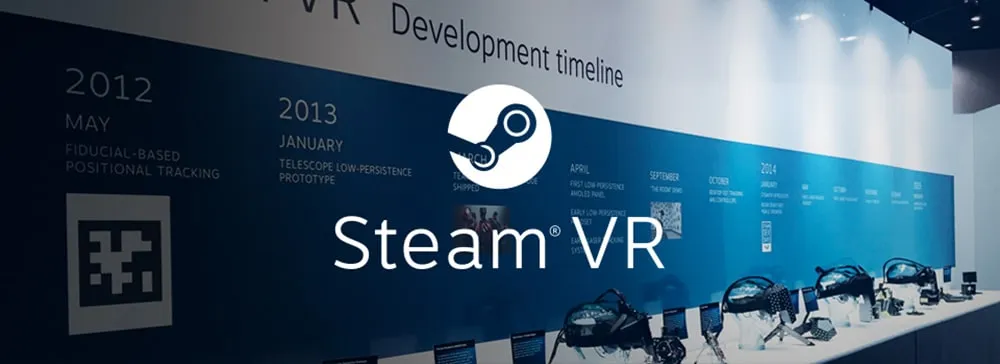Valve Software, the technology partner that made the HTC Vive possible, is offering “new core components” to VR hardware manufacturers, including custom lenses “designed to support the next generation of room-scale virtual reality.”
Earlier this year Valve started freely licensing its innovative SteamVR Tracking technology. This tech has been critical to the HTC Vive’s functionality as it lets people explore entire rooms while completely immersed in a virtual world. We saw the technology employed in a prototype from LG earlier this year and HTC is building on it to bring a whole host of accessories into VR. Meanwhile, Valve is preparing to unleash a second generation of the technology which could make it far less expensive while enabling entire warehouses to be tracked.
Now Valve appears to be aiming to court additional manufacturers for VR headsets with a widened selection of components including new custom lenses. Its press release, included below, describes support for both LCD and OLED display manufacturers. While Vive and Facebook’s Oculus Rift both use OLED panels, low-persistence LCDs are used in some of the lower cost Microsoft headsets debuting at the end of 2017. Valve seems to be offering manufacturers another option besides Microsoft in adopting these LCDs with “custom hardware and software manufacturing solutions.”
Valve also “developed custom lenses that work with both LCD and OLED display technologies and is making these lenses available to purchase for use in SteamVR compatible HMDs.” Combined with Valve’s software, the lenses are designed “to be paired with several off-the-shelf VR displays to enable the highest quality VR visual experiences. These optical solutions currently support a field of view between 85 and 120 degrees (depending on the display). The lenses, which are designed to support the next generation of room-scale virtual reality, optimize the user’s perceived tracking experience and image sharpness while reducing stray light.”
For those unfamiliar, Microsoft and Valve are employing different approaches to tracking technologies for VR headsets. Microsoft’s “inside-out” solution is more convenient because no external hardware is needed, but it won’t fully track hand movements when they are out of the view of sensors embedded on the headset itself. Valve’s “outside-in” technology typically requires mounting a pair of boxes to your walls, but enables headsets to be tracked through the entire area alongside other objects. This works even if holding your controllers behind your back. So while Valve’s approach requires a little more setup, it’s possible that with extended use across many virtual worlds, Valve tracking might provide a more immersive and reliable solution. To be clear, this is conjecture still as we need to stress test Microsoft’s controllers to see how often the out-of-view tracking limitation comes up.
Press release from Valve below:
Valve Offers More Core Virtual Reality Technologies to Device Manufacturers
October 9, 2017 — Valve, creator of Steam and SteamVR, a leading platform for games and virtual reality (VR) applications, today announced the availability of new core components needed by VR hardware manufacturers to deliver best in class VR systems.
Complementing the existing free license for sub-millimeter room-scale tracking and input technology, today’s news marks the addition of other critical pieces for developing state-of-the-art VR hardware: an advanced optical system, manufacturing and calibration tools, and the supporting software stack to unify the hardware into an optimal user experience.
“World class VR requires highly precise tracking, matched optics and display technologies, and a software stack that weaves together the interactions between these components,” said Jeremy Selan of Valve. “For the first time, we’re making all of these technologies available to anyone who wants to build a best in class VR system for the millions of Steam customers accessing over 2,000 SteamVR compatible titles.”
About the Display and Optics Technology
Valve has spent years working closely with display manufacturers to adapt their technologies to the unique challenges of VR. Recent advancements in Liquid Crystal Display (LCD) technology combined with VR specific calibration now make it a viable technology choice for high end VR systems. LCD manufacturers have demonstrated fast-switching liquid crystals, low persistence backlights, and high PPI displays that, when calibrated and paired with the right software, are well matched to the highest quality VR experiences. Of course, organic light-emitting diode (OLED) display technology was critical to the first generation of VR (being first to demonstrate fast transition times and low-persistence illumination), and it remains an excellent option for new head mounted displays (HMDs). While both display technologies have inherent artifacts unique to head-mounted usage, Valve provides custom hardware and software manufacturing solutions as part of the SteamVR technology suite to enable high quality visual VR experiences.
In addition, Valve has developed custom lenses that work with both LCD and OLED display technologies and is making these lenses available to purchase for use in SteamVR compatible HMDs. These lenses and Valve’s unique calibration and correction software are designed specifically to be paired with several off-the-shelf VR displays to enable the highest quality VR visual experiences. These optical solutions currently support a field of view between 85 and 120 degrees (depending on the display). The lenses, which are designed to support the next generation of room-scale virtual reality, optimize the user’s perceived tracking experience and image sharpness while reducing stray light. Valve is including the custom lens calibration and correction software within the SteamVR technology suite.
Finally, Valve continues to offer full room-scale, sub-millimeter tracking technology by providing a reference design for the “Watchman” tracking module and by offering Valve manufactured base stations with SteamVR Tracking 2.0 technology for sale to licensees.
For more information about VR technology licensing, please see https://partner.steamgames.com/vrlicensing


























